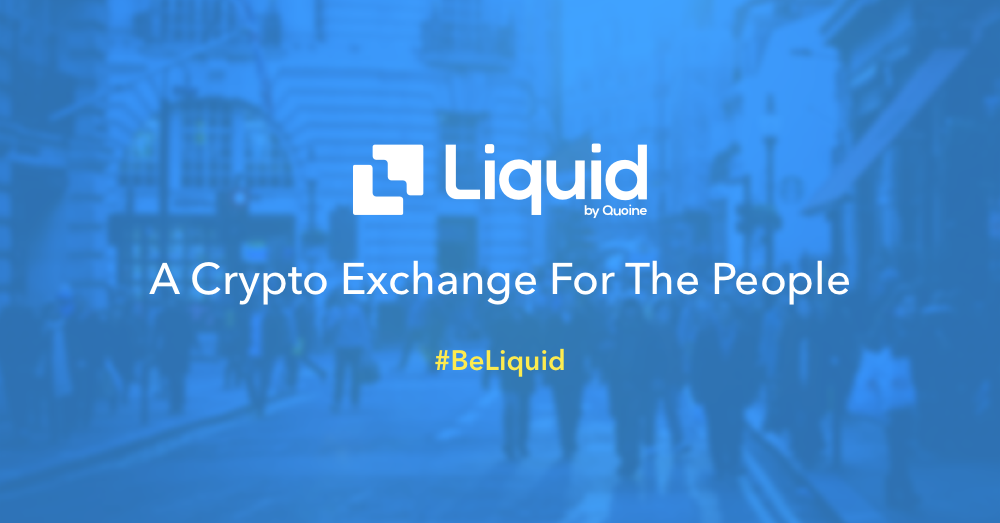The Liquid exchange, developed by Quoine, is one of the world’s largest crypto exchanges, home to several tokens and regularly seeing over $100 million in 24-hour trading volume.
We spoke to Liquid’s Head of North American Operations, Nick Chong, about the exchange, industry developments, the future of cryptocurrency and more.
 At Liquid, Chong is responsible for the expansion of the Liquid crypto exchange platform in the U.S. and Canada, including a wide array of services for blockchain startups spanning ICOs and token listings, as well as strategic partnerships.
At Liquid, Chong is responsible for the expansion of the Liquid crypto exchange platform in the U.S. and Canada, including a wide array of services for blockchain startups spanning ICOs and token listings, as well as strategic partnerships.
In December 2018, a market report by the Blockchain Transparency Institute shows that many of the biggest exchanges feature only a fraction of genuine trading volume, with wash trading being quite prominent. Liquid was one of the odd ones out. How do you see this affecting the market?
Crypto industry insiders have known for the longest time that many exchanges post fake volumes, but this had been relatively under the radar until recently.
I applaud the Blockchain Transparency Institute for bringing to light, through systematic empirical analysis, that some exchanges are grossly overstating their liquidity — by a factor of up to 50x in some cases. While many exchanges have been competing for a “top 10 spot on Coinmarketcap” as a primary goal to be achieved at any cost, we believe that transparency, security, and compliance with regulations are goals that are as important, if not more important.
Exchanges that wash trade are not only deceiving, but also shortchanging their customers, as the lack of real liquidity represents a hidden cost, leading to slippage and poor price execution. The consequence of fake volumes is very real, and traders are starting to take notice. I would bet that in the longer run “top 10 exchange rankings” will become less and less meaningful in the eyes of traders.
With Binance and Coinbase, arguably two of the biggest exchanges, implementing new features, such as Binance’s DEX, how does Liquid plan to stand out in a very competitive space?
As a crypto-to-fiat exchange, we need to do a good job as a gateway into the crypto world, so that both sophisticated investors and first time buyers can purchase and trade.
We will soon be rolling out better funding options allowing our users to fund using fast and low cost payment methods, in a variety of fiat currencies. We are working very hard on building relationships of trust with banks and other financial partners who are very selective when servicing crypto companies.
Soon, near-instant bitcoin deposits will be available to Liquid users thanks to our AI technology that analyzes each transaction as it reaches the mempool, enabling us to confirm incoming funds in a matter of seconds.
I should also mention that Liquid already supports advanced trading tools, such as margin trading, as well as crypto asset lending. This last one is a particularly attractive proposition to many traders, as they can collect interest by lending out their crypto assets, without it leaving our exchange’s wallets.
As you rightly say in the QASH token’s whitepaper, liquidity is a significant obstacle for the growth of the crypto market. Can you describe how Liquid’s platform World Book, Smart Order Routing and Prime Brokerage features might remedy this problem?
There are around 250 crypto exchanges listed on Coinmarketcap, which provide liquidity for a total of $120 billion in crypto assets. Compare this to traditional stock exchanges, with around 60 major exchanges for a $300 trillion stock market cap.
What emerges is that there are just too many crypto exchanges considering the size of the crypto market, and consequently liquidity is spread across very thinly.
To put some perspective on the size of this problem, in surveys traders often mention “lack of liquidity” as a top 3 concern when using exchanges, forcing many of them to use OTC brokers for larger transactions, who have been doing good business due to exchanges’ Achilles heel.
In an exchange, matching orders to execute a trade requires a “double coincidence of wants.” For every buyer, a seller must be found that is willing to sell at the correct price, without which the order does not get filled. Exchanges are limited because they can only match orders that are on the same order book.
But what if we could match three, four, or more orders by trying to find matches in multiple orders books? It would be much easier to find matches. And what if those order books exist on not only one exchange, but multiple exchanges who work to combine their order books together?
Liquidity would not longer be “siloed” across multiple exchanges — we solved our problem of lack of liquidity. In a nutshell, this is the idea behind Liquid’s World Book, which will be rolled out later this year.

How has Liquid’s self-service ICO platform been faring? With ICOs being a hot issue for regulators, what checks do you think a launch platform should have in place to ensure that investors are protected?
Our risk management procedures require us to conduct a thorough due diligence on every project that we onboard to our ICO platform. This includes a review of the whitepaper, the key members of the team, their roadmap, their seed funding, and the tokenomics of their future token.
We ask ourselves, should this project receive funding via an ICO, does this project have a reasonable chance of becoming a successful startup company, and can the token survive in the longer run? We also perform KYC on all market participants and ask for a legal review of the token from a credible law firm.
Liquid is fully regulated in Japan, a country where cryptocurrency is highly popular. Are there any similar plans for other countries?
There is very large gap in between Japan’s approach to regulations and that of other countries. The contrast could not be greater.
Regulators in most countries are just beginning to implement anti-money laundering laws and other regulations to require people to pay income tax on their crypto gains. If we take as a precept that Bitcoin is a financial instrument, which I strongly believe it to be, then of course we need to make sure that it cannot be used by criminals and that people pay capital gains taxes. This is most basic.
But what about protections for investors?
Taking as a case study the recent failure of Canadian exchange QuadrigaCX, a story close to home as I am Canadian, some commentators suggested that users themselves were to blame for the loss of $170 million of crypto assets: “Users should move their crypto to their personal wallets and store their private keys in a safe place!” they said.
It was suggested that Canadian regulators could not have done anything (as crypto does not fall under their purview), and that the industry itself should self-regulate.
I could not disagree more. If we as an industry want to encourage adoption of crypto, we need to make access both convenient and safe at the same time. Does the teller at the bank advise you, after cashing your check, to take your bills and store them in a safe place at home? The crypto industry needs to accept that not everyone is able to (or even wants to) be responsible for safeguarding their own funds.
As a regulated exchange in Japan, we are required to implement measures, such as multi-signature wallets, so that no single person has access to the crypto assets without the authorization of at least one other person. Even our CEO is not permitted to have sole control of the wallet.
For cryptocurrencies that do not support multi-signature, which is the case of some non-Bitcoin cryptocurrencies, the regulator imposes management procedures and logging as risk mitigation measures.
The implementation of best practices such as these have been discussed at length by non-official industry bodies such as the JVCEA, JBCA, JBA (Japan Virtual Currency Exchange Association, Japan Cryptocurrency Business Association, and Japan Blockchain Association, respectively) and evidences the relative sophistication of Japan’s cryptocurrency industry in terms of investor protections.
Now compare this to Canada, where other than AML laws in a single province, there are no regulations at all for cryptocurrencies. Even if the industry was to self-regulate, the lack of transparency would be an issue: would QuadrigaCX have openly shared with others that it its CEO was the only individual with access to the private keys?
In a self-regulating industry association, exchanges would be hesitant to share information with competitors: There is a conflict between using information to verify that each member is implementing best practices, and using information to know what your competitor is up to. This is why I believe regulators need to step in.
As far as major regions go, Asia is seen as a hub for cryptocurrency and exchange development. Do you see the United States and the European Union standing to lose a lot of ground with their laggard, though increasing, pace in forming regulations?
Yes, they do, at least in the short term.
Regulators in G7 countries and other major countries (with the exception of Japan) are slow to act, which made it possible for a number of small “tax haven” nations to attract crypto companies by creating crypto-friendly regulations. These so-called “crypto-hubs” allow companies to operate with legal clarity in that small country, but they do nearly nothing to legalize their operations outside of the country.
You can isolate yourself on an island, but that does not make what you are doing any more legal in the United States or Japan.

How do you see the fundamentals for market growth — institutional investment, scaling solutions and so on — progressing in 2019?
I believe that 2019 will be the year that the industry develops critical infrastructure needed for crypto adoption. We can think of ETFs and custody solutions as good examples.
Although the “crypto winter” is causing many casualties in the industry, I think there is also a silver lining. The industry is going through a necessary purification process where less well-managed, less secure and compliant actors are going away, while consumers are getting smarter about crypto by learning from mistakes.
This will allow the industry to emerge stronger.
It’s quite evident that cryptocurrency and blockchain will take a few more years to fully develop. What specific applications do you expect will gain the most traction in the upcoming years?
There are almost too many to mention. At its core, blockchain allows to build trust where no trust exists, whether it is used to exchange assets as payment, or information that is highly confidential.
I think that the identity and financial information industry is ripe to be disrupted by blockchain. Why is your government-issued ID the only accepted “single source of truth” that you exist in this world and that you are who you say you are? Why should only 2 or 3 credit bureaus control all the private financial information of Americans?
Likewise, counterfeiting is a major issue for many consumer goods. Blockchain can help authenticate the origin of food and luxury products.
Digital assets are now growing in legitimacy, but many would-be investors remain slightly hesitant about investing in the asset class. What would you say to convince these investors to begin investing in it?
I would first ask any would-be investor: do you normally invest for the short term or the long term? Looking around me at my friends and family, most of them plan their portfolios thinking of years down the line.
If you are only looking at crypto’s lacklustre performance in the last 12 months to draw conclusions, I think that you are seeing the trees instead of the forest. Bitcoin recently celebrated its 10th anniversary — how many people knew in 2009 what heights it would would reach 10 years later?

